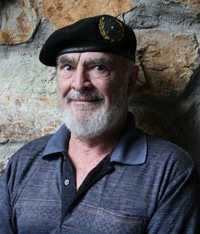Meet Park West’s newest Australian artists
When it comes to bringing the best to its collectors, Park West Gallery reviews artwork from all over the world and is proud to introduce some of its newest artists from Down Under. Read on to [...]

1939–
Robert Pope was born in 1939 at Bendigo, Victoria, Australia, the son of a cyanide plant operator who worked on the famous Bendigo Goldfields extracting gold. Pope aspired at an early age to become an artist-philosopher, though his father considered this ridiculous, as Pope was classified as colorblind. Instead, Pope found that he sees colors vividly, much like his artistic hero, 19th-century artist J.M.W. Turner.
READ MORE +Pope’s mother encouraged him to attend art school. After she passed when he was 14 years old, he delayed his artistic dream and went to find work in North Queensland. He became a self-taught senior seismic cartographer, working throughout outback Australia. In 1964 he resigned to open his own gallery, and only four years later, won the Inaugural Centralian Caltex Art Award.
Pope’s science-art theories were documented by the Science Unit of Australian National Television in 1978 during his Artist-in-Residency at the University of Adelaide. This documentary premiered internationally the following year. This led to UNESCO appointing him as a Special Science-Art Delegate to a world Summit Meeting on General Relativity at the International Centre for Theoretical Physics in Trieste, Italy.
Alongside being a professional artist, Pope is a science-art philosopher. He says he aims to re-write science itself in order to unite human artistic feelings with emotional science. Even so, art remains at the core, and allowing Pope to portray his ideas and beliefs for collectors to appreciate.
Pope’s artwork is inspired by art from ancient cultures such as Egyptian, Islamic and Byzantine. He works with acrylics, building upon layers of paint to mimic the look of ancient relics. The symbols in his works represent that there is a wealth of knowledge to be learned from previous cultures. Pope believes this knowledge is important to “restore the imbalance between the arts and sciences in the modern world.”
A studio complex and residence known as The Castle on the Hill is located in Northern New South Wales. It was hand-built by himself and fellow artist Robert Todonai. It has been the subject of many television and magazine articles. The building also serves as the headquarters of the Science-Art Research Centre of Australia, a research institute approved by the Australian government. Pope serves as the center’s director.
Awards and recognition
for breaking news, artist updates, and special sale offers